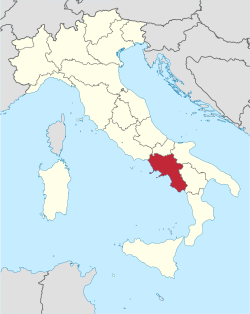Campania | |
|---|---|
 | |
| Coordinates: 40°54′38″N 14°55′14″E / 40.91056°N 14.92056°E[1] | |
| Country | |
| Capital | Naples |
| Government | |
| • President | Vincenzo De Luca (PD) |
| • Legislature | Regional Council |
| Area | |
| • Total | 13,671 km2 (5,278 sq mi) |
| Population (30 April 2023) | |
| • Total | 5,580,567 |
| • Density | 410/km2 (1,100/sq mi) |
| Demonyms | |
| GDP | |
| • Total | €110.231 billion (2021) |
| Time zone | UTC+1 (CET) |
| • Summer (DST) | UTC+2 (CEST) |
| ISO 3166 code | IT-72 |
| HDI (2021) | 0.856[3] very high · 19th of 21 |
| NUTS Region | ITF |
| Website | www |
Campania[a] is an administrative region of Italy located in Southern Italy; most of it is in the south-western portion of the Italian Peninsula (with the Tyrrhenian Sea to its west), but it also includes the small Phlegraean Islands and the island of Capri. The capital of the Campania region is Naples.[6] As of 2018, the region had a population of around 5,820,000 people, making it Italy's third most populous region,[7] and, with an area of 13,590 km2 (5,247 sq mi), its most densely populated region. Based on its GDP, Campania is also the most economically productive region in Southern Italy and the 7th most productive in the whole country. Naples' urban area, which is in Campania, is the eighth most populous in the European Union.[8] The region is home to 10 of the 58 UNESCO sites in Italy, including Pompeii and Herculaneum, the Royal Palace of Caserta, the Amalfi Coast, the Longobardian Church of Santa Sofia in Benevento and the Historic Centre of Naples. In addition, Campania's Mount Vesuvius is part of the UNESCO World Network of Biosphere Reserves.[9]
The Campania's hinterland was inhabited from the beginning of the 1st millennium BC by the Osci, Samnites and Etruscans, while between the 8th and 7th centuries BC its coastal areas were colonised by the ancient Greeks (Magna Graecia). At that time, Capua was Campania's leading city, while Naples was an anomaly, being predominantly Greek-speaking.[10]
Campania is rich in culture, especially with regard to food, music, architecture, and archaeological and ancient sites—such as Pompeii, Herculaneum, Oplontis, Paestum, Aeclanum, Stabiae, and Velia. The name "Campania" is derived from Latin; the Romans knew the region as Campania felix ("fertile countryside" or "happy countryside"). The rich natural beauty of Campania makes it important to the tourism industry: the city of Naples, the Amalfi Coast, Mount Vesuvius, and the islands of Capri and Ischia have long been major attractions.[11]
- ^ Campania in Geonames.org (cc-by)
- ^ "Population on 1 January by age, sex and NUTS 2 region", www.ec.europa.eu, archived from the original on 25 December 2023, retrieved 29 December 2023
- ^ "Sub-national HDI - Area Database - Global Data Lab". hdi.globaldatalab.org. Archived from the original on 23 September 2018. Retrieved 5 March 2023.
- ^ "Campania". Collins English Dictionary. HarperCollins. Archived from the original on 6 May 2019. Retrieved 6 May 2019.
- ^ Upton, Clive; Kretzschmar, William A. Jr. (2017). The Routledge Dictionary of Pronunciation for Current English (2nd ed.). Routledge. p. 183. ISBN 978-1-138-12566-7.
- ^ "Campania, Italy". Archived from the original on 24 September 2021. Retrieved 24 September 2021.
- ^ demo.istat.it (ed.). "Bilancio demografico Anno 2018 (dati provvisori)". Archived from the original on 14 January 2018. Retrieved 30 April 2015.
- ^ "Statistics on European cities - Statistics Explained". ec.europa.eu. Archived from the original on 12 June 2020. Retrieved 20 April 2020.
- ^ "UNESCO - MAB Biosphere Reserves Directory". www.unesco.org. Archived from the original on 5 January 2020. Retrieved 20 April 2020.
- ^ Gradogna, Sergio (10 February 2010). "Non solo greci e romani, la Campania degli altri popoli". Charme (in Italian). Archived from the original on 19 February 2022. Retrieved 19 February 2022.
- ^ "Campania: Gateway to Southern Italy". LifeInItaly.com. 7 October 2007. Archived from the original on 15 August 2009. Retrieved 22 July 2009.
Cite error: There are <ref group=lower-alpha> tags or {{efn}} templates on this page, but the references will not show without a {{reflist|group=lower-alpha}} template or {{notelist}} template (see the help page).

